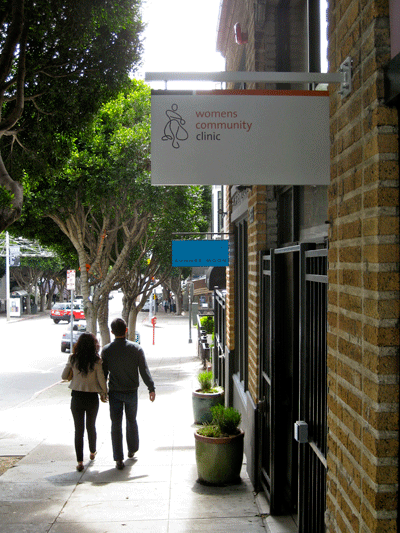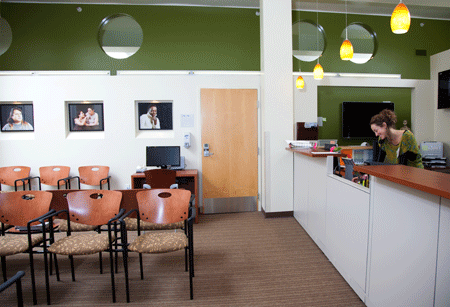
The Women's Community Clinic has moved to 1833 Fillmore.
By Barbara Kate Repa
“Amazing!” is the word clients use most frequently to describe their experiences at the Women’s Community Clinic, which is settling into a refurbished space at 1833 Fillmore. That’s followed by a sea of compliments rarely enthused by those experiencing gynecological exams: “compassionate,” “efficient,” “informative,” “respectful.”
In addition to rave reviews, what makes the clinic unusual is its focus on delivering medical care of high quality at no charge to women in need.
“We offer care for women by women — with an all female staff — to those in the community who are uninsured, underinsured or simply don’t feel safe or understood by many medical care providers,” says Carlina Hansen, the clinic’s executive director, who first came to the clinic as a volunteer in 1999.
“I adored the work the clinic did, but especially the focus on helping those with inadequate insurance,” says Hansen, who had witnessed her father’s battle to navigate the medical system without insurance during a serious illness.
The Women’s Community Clinic’s arrival in the neighborhood in mid-March also affords local residents the opportunity to volunteer — and allows a few of them to take on paid fellowships to test a career in health care.
Unlike other embattled clinics, which have cut back or closed, the Women’s Community Clinic has flourished. It recently added mental and behavioral health services — and soon will expand to offer prenatal care. When Hansen began working at the clinic a dozen years ago, there were two staff members and about 25 volunteers. Now those ranks have swelled to 26 staff members and 100 volunteers. Of those volunteers, 25 are medical practitioners; the others keep more than busy doing outreach, mailings, accounting and public relations. No willing hands and hearts are turned away.
The clinic’s volunteer model may save as much as $500,000 in yearly costs compared to a conventional medical clinic operating entirely with paid staff. Outreach efforts aimed to “meet women where they are” include a weekly Ladies’ Night in the Mission District in which trained volunteers dole out information on health and well being along with condoms, toothbrushes and clean hypodermic needles. The clinic also trains and sponsors Condom Ladies, who volunteer twice weekly to distribute information and safer sex materials on the streets and in single room occupancy hotels.

The newly refurbished clinic offers free medical care for women.
The Women’s Community Clinic is unique in the Bay Area in providing medical services by volunteers working as clinicians, client service coordinators, health educators and outreach managers. Volunteer positions — which come with targeted training and a taste of a career in health care — are coveted. More than 150 hopeful applicants recently put in their bids for 30 unpaid spots. Volunteers are asked to commit to a four-hour shift every week for six months.
“We would really love to have volunteers from the neighborhood,” says Hansen, who adds that the current need is for more doctors and nurse practitioners, who are asked to make a commitment of two four-hour shifts monthly.
“Volunteering here allows them to practice the way they want to practice, without having to rush through appointments in an allotted time,” says Hansen, who adds the arrangement is especially attractive for medical professionals who are mothers or who might be cutting back on their work hours but want to keep their skills fresh.
Dr. Rhoda Nussbaum, an OB/GYN who founded Women’s Health for Kaiser in Northern California, began volunteering at the Women’s Community Clinic a few years before she retired in 2007. “What attracted me at first is that it’s truly a service organization — providing a service to those who would not otherwise have access to medical care, and providing it to them free,” she says. “From my perspective, it’s a privilege to serve people. But when it’s done for no rewards, it’s sweeter.”
Another pull is the camaraderie. “Because it’s a volunteer clinic, it’s an organization of people who are there because they choose to be,” she says. “People are always smiling. It’s really a place of love.” And Nussbaum says the move to Fillmore has energized many who work there. “I’m excited about being on Fillmore,” she says. “And I think the clinic will be good for the neighborhood, because some of the good feelings and warm positive energy will just pour out into the street.”
The clinic originally opened at 2166 Hayes in July 1999, just five months after the Women’s Needs Center, an adjunct of the Haight-Ashbury Free Clinic, closed its women-only services in the same spot due to a lack of funding. But resolute staff and volunteers went to work twisting arms of people they found in their Rolodexes and raised more than $100,000 from a local foundation, plus a city contract and individual donations — enough money needed to get the operation up and running.
Within six months, tragedy struck. Thieves broke in and made away with essential office equipment, clothes designated for clients — and, oddly, several limited edition prints of women and contraceptive devices. History repeated itself last December when burglars again broke into the Hayes Street office, making off with computers and other office equipment and jeopardizing the group’s year-end fundraising efforts.
“We’ve known for years we were outgrowing the space,” says Hansen. Leaks, floods and two burglaries provided added impetus to make the move. “Also, the new quarters on Fillmore offer clients a nicer and more welcoming environment.” It’s a return home of sorts for Hansen, who attended the Convent High School on Broadway years ago.
“When we knew we were moving, we started talking with people in the community about the needs here — particularly the needs of young African American girls in the Western Addition,” Hansen says. “And we found the two things they needed most were access to health care and career opportunities.”
The new quarters, with three times the space of the Hayes location, will significantly increase access to the clinic, which now serves about 5,000 clients each year in about 450 visits per month. Most clients seek information on gynecological health, family planning and birth control, pregnancy testing and treatment of infections and menopause symptoms.
As for career opportunities, the clinic offers several paid two-year Western Addition Health Training fellowships in which participants learn basic office functions such as charting and scheduling, are intensively monitored by staff and then trained to do patient outreach and other clinical work.
“We hear a lot about the impact the Women’s Community Clinic has on career paths,” Hansen says, noting that 65 percent of the fellows move into health care jobs. “We provide medical services to our clients — but our volunteers are our clients, too.”

Staffers and volunteers will use the exam rooms in the clinic's new home.
The new digs on Fillmore afford double the number of exam rooms, several health education rooms in which clients meet with trained volunteers to discuss their concerns before they see a practitioner, plus a large conference room for training and group meetings. Administrative staff, who were crammed three to a small room that doubled as a kitchen, also have more space and privacy.
The site formerly housed another women’s clinic, the Bayspring Medical Group, which moved to 1199 Bush a few years ago. Before the Women’s Community Clinic could move in, it needed to remodel the space to bring it up to code. Hansen says the work took the lion’s share of the total $2 million budget. “And that wasn’t the sexy part of the renovation,” she says.
That came later, with the walls outfitted in shades of cream and grassy green — the paint donated by new neighbor Ralph Lauren. All fixtures and furniture are new or “gently used.” Fresh carpet was installed throughout and the waiting room is equipped with a kids’ play area and a computer workstation for clients. About $750,000 is still needed to complete the work on the new space, which will need to come from donations. Hansen says the clinic follows a strict dictate not to borrow money.
Hansen acknowledges that health care reforms may mean the Women’s Community Clinic will soon need to reassess, and has just secured a grant for that planning process. “Our focus may change if everyone’s insured. The irony is that our volume would likely increase because more women would have access to medical care,” she says. “We’ll need to make still more changes to stay relevant. But right now it’s a little like throwing a dart at a moving dartboard.”
Filed under: Body & Soul





